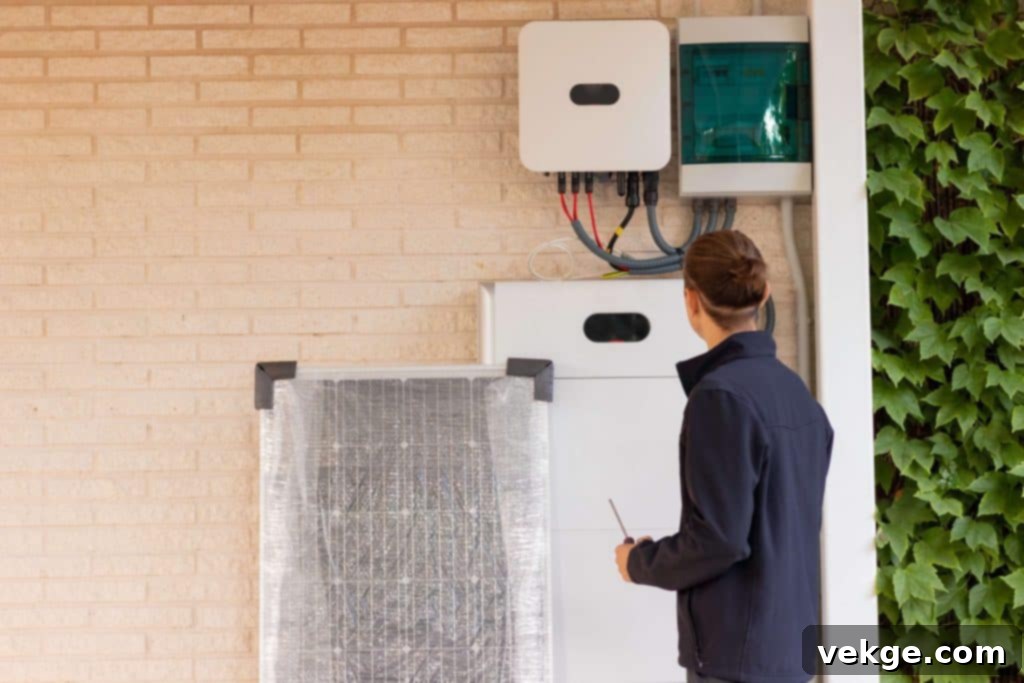Power Your Future: Unlock Energy Savings and Independence with Home Batteries
In an era defined by a global imperative for sustainability and a growing desire for energy independence, home batteries have emerged as a truly transformative technology. More than just a convenience, these sophisticated energy storage systems are reshaping how homeowners interact with their power, offering a potent blend of cost savings, enhanced reliability, and a significant step towards a greener future. By capturing and storing energy for later use, home batteries empower individuals to take greater control over their energy consumption and protect themselves against grid uncertainties. This comprehensive article delves into the multifaceted ways home batteries can drastically reduce your energy expenditures, fortify your home against power outages, and provide a more efficient, reliable, and sustainable energy solution for the modern household.
Understanding Home Batteries: The Core of Residential Energy Storage

At their essence, home batteries, often referred to as residential energy storage systems (RES), are intelligent devices designed to store electrical energy. This stored power can then be discharged and utilized at a later time, according to the homeowner’s needs or the prevailing electricity market conditions. While they are most commonly and effectively paired with renewable energy sources like rooftop solar panels, home batteries offer versatility. They can also be charged directly from the traditional electricity grid, particularly during off-peak hours when electricity rates are typically at their lowest. The stored energy serves multiple critical functions: it can be deployed during periods of high electricity demand (peak hours) to avoid expensive rates, provide a crucial lifeline during unexpected power outages, or supplement the energy supply when renewable generation, such as solar output on a cloudy day, is insufficient. Innovative solutions like the Home Battery from EcoFlow exemplify the advanced capabilities and reliability that modern residential energy storage systems bring to homeowners, offering seamless integration and efficient power management.
The Mechanics of Home Batteries: How They Work to Your Advantage
The operational principle behind home batteries is elegantly simple yet incredibly powerful. These systems work by accumulating surplus energy generated by your solar panels – energy that isn’t immediately consumed by your household. Alternatively, they can draw electricity from the grid when demand is low, and consequently, electricity rates are at their most affordable. This collected energy is then stored within the battery cells, poised for future deployment. When the demand for electricity within your home escalates, for instance, during the evening when families are typically at home using various appliances and electronics, or when the grid experiences a disruption, the stored energy is automatically discharged to power your home. This intelligent management of energy flow ensures that you’re maximizing the utility of your own generated power and minimizing reliance on expensive grid electricity when it matters most.
Capitalizing on Peak Shaving and Time-of-Use (TOU) Rates
One of the most immediate and substantial financial benefits of integrating a home battery system stems from its ability to perform “peak shaving” and optimize energy usage under “time-of-use” (TOU) electricity rate structures. In many regions, utility companies implement variable electricity rates that fluctuate throughout the day. These rates are significantly influenced by overall demand; during peak hours, often late afternoon and early evening when most households are active, electricity prices can skyrocket. Conversely, during off-peak hours, such as overnight or in the middle of the day, rates are considerably lower.
Home batteries empower homeowners to strategically navigate these fluctuating rates. By charging the battery when electricity rates are at their lowest (off-peak) and then drawing power from the battery when rates are at their highest (peak), homeowners can effectively “shave off” their peak demand from the grid. This practice directly translates into substantial savings on monthly energy bills. The battery acts as a financial buffer, allowing you to consume your own stored, inexpensive energy precisely when grid power would be most costly, turning energy management into a form of smart financial arbitrage.
Enhancing Energy Security: Reducing Dependence on the Grid

Beyond financial savings, a critical advantage of home batteries is the profound enhancement of energy security and a significant reduction in dependence on the centralized utility grid. By generating your own clean energy (typically with solar panels) and storing it locally, you create a self-sufficient energy ecosystem for your home. This translates into greater resilience and peace of mind, especially in an era marked by increasing grid instability and the growing frequency of extreme weather events.
During a power outage, when the conventional grid goes down, a well-integrated home battery system can seamlessly switch to providing backup power. This ensures that essential devices and appliances – such as refrigerators, medical equipment, lighting, and communication devices – continue to operate uninterrupted. For homes in areas prone to frequent outages, severe storms, or natural disasters, this capability is not merely a convenience but a vital safeguard, protecting food, health, and connectivity. Modern battery systems often feature “islanding” capabilities, meaning they can safely disconnect from the main grid and power your home independently, ensuring continuous operation even when the neighborhood is dark.
Optimizing Self-Consumption and Navigating Net Metering Changes
Historically, “net metering” programs have allowed solar panel owners to sell any excess electricity their panels generate back to the grid, typically receiving credits on their bill. While beneficial, a common drawback is that the rates paid for this excess energy are often lower than the rates charged for drawing electricity from the grid. This disparity means that simply exporting power might not always be the most economically advantageous strategy.
Home batteries fundamentally change this dynamic by allowing homeowners to maximize “self-consumption” of the energy they generate. Instead of selling excess solar power back to the grid at a potentially lower rate, the battery stores it for your own future use. This means you can power your home with your own clean, free energy during times when you would otherwise be forced to buy expensive electricity from the utility. As net metering policies evolve and sometimes become less favorable to homeowners, the ability to store and use your own energy becomes increasingly valuable, leading to more significant long-term cost savings and greater energy independence.
Mitigating Demand Charges and Fostering Energy Efficiency
Beyond Time-of-Use rates, some utility companies, particularly for larger residential or commercial customers, impose “demand charges.” These charges are based on the highest amount of power (measured in kilowatts, kW) consumed at any single point during a billing cycle, rather than just the total energy consumed (kilowatt-hours, kWh). A sudden surge in power usage, even if brief, can trigger substantial demand charges.
Home batteries are excellent tools for managing and reducing these demand charges. By discharging stored energy during periods when power consumption might otherwise spike, homeowners can effectively lower their peak power usage from the grid, thereby reducing or even eliminating demand charges. Furthermore, home batteries inherently promote greater overall energy efficiency. Modern smart battery systems are often equipped with advanced algorithms and AI-powered management capabilities. These systems can learn your household’s energy consumption patterns, forecast solar generation, and optimize charging and discharging cycles to ensure that energy is used in the most efficient and cost-effective way possible. This intelligent management minimizes waste and further slashes energy costs.
Leveraging Incentives and Rebates to Reduce Upfront Costs
The upfront cost of purchasing and installing a home battery system can be a significant consideration for many homeowners. However, numerous governments, states, and local utility companies actively encourage the adoption of home batteries and other renewable energy technologies through a variety of attractive incentives and rebates. These programs are designed to make clean energy solutions more accessible and affordable, significantly reducing the initial investment required.
Incentives can take many forms, including federal tax credits (such as the Investment Tax Credit in the United States, which applies to solar-plus-storage systems), state-specific grants, local utility rebates, and even performance-based incentives that reward homeowners for providing grid services. These financial benefits can dramatically shorten the payback period for a home battery system, making the economic case for adoption even stronger. Homeowners are strongly encouraged to research available programs in their specific region, as these incentives can vary widely and often represent a substantial portion of the system’s cost.
The Future of Energy Storage: A Landscape of Innovation
The home battery market is not just growing; it’s rapidly evolving, propelled by relentless technological innovation and a surging global demand for sustainable energy solutions. Battery technology has advanced dramatically over recent years, with modern residential batteries offering significantly greater energy density (meaning more power in a smaller footprint), substantially longer lifespans (often measured in thousands of charge/discharge cycles), and enhanced safety features. Research and development continue to push boundaries, exploring next-generation chemistries like solid-state batteries and flow batteries that promise even greater performance, safety, and reduced environmental impact.
As these technologies mature and manufacturing processes become more efficient, the cost of home batteries is projected to continue its downward trend. This increasing affordability, coupled with ongoing performance improvements, will make home batteries an even more compelling and ubiquitous option for homeowners worldwide. Furthermore, the integration of home batteries into “virtual power plants” (VPPs) – networks of distributed energy resources that can collectively provide services to the grid – hints at a future where individual home batteries contribute to broader grid stability and resilience, potentially offering additional financial benefits to participating homeowners.
Real-World Impact: Case Studies and Tangible Benefits
To truly grasp the transformative power of home batteries, examining real-world applications provides invaluable insight. Consider the experiences in California, a state notorious for its high energy prices, frequent Public Safety Power Shutoffs (PSPS), and extensive Time-of-Use rate structures. Thousands of homeowners have embraced home battery systems, often paired with solar. These systems have enabled them to dramatically reduce their monthly energy bills by strategically avoiding peak TOU rates. Crucially, they have also provided an indispensable source of backup power, ensuring their homes remain illuminated and functional during grid outages, offering a level of security previously unattainable.
Another compelling example comes from a family in Texas, a region susceptible to extreme weather events that can cripple the grid. After installing a home battery system in conjunction with their existing solar panels, they began storing excess solar energy generated during the day. By discharging this stored energy during the late afternoon and evening peak demand times, they reported cutting their energy bills by nearly 50%. Beyond the financial aspect, the system provided profound peace of mind during severe winter storms and summer heatwaves, ensuring their home maintained power for heating, cooling, and essential services even when the broader grid failed. These stories underscore the dual benefits of financial savings and enhanced resilience that home batteries deliver.
Practical Considerations for Home Battery Installation

For those contemplating the installation of a home battery system, a thorough evaluation of several practical factors is essential to ensure the chosen system aligns perfectly with your needs and maximizes your investment:
- System Sizing: Tailoring to Your Needs
The capacity and power output of your home battery system must be carefully matched to your household’s specific energy requirements. This involves a detailed assessment of your daily energy consumption patterns, identifying your peak usage times, and determining which appliances you wish to power during an outage. An undersized battery won’t meet your needs, while an oversized one can be an unnecessary expense. Professional energy audits and consultations are crucial for accurate sizing. - Seamless Integration with Solar Panels: Maximizing Synergies
Home batteries achieve their highest efficiency and provide the greatest benefits when integrated with a solar photovoltaic (PV) system. If you already have solar panels, adding a battery system is a logical next step to maximize self-consumption and energy independence. For new installations, planning for both solar and storage simultaneously can optimize design and reduce overall installation costs. Ensure compatibility between your existing or planned solar inverter and the battery system. - Cost, Financing, and Return on Investment (ROI)
While the upfront cost of a home battery system can be substantial, it’s crucial to consider the long-term savings and benefits. Explore various financing options, including specialized green energy loans, property-assessed clean energy (PACE) programs, and manufacturer financing. Carefully calculate the potential return on investment (ROI) by factoring in avoided energy costs, potential incentives, and the value of enhanced energy security over the system’s lifespan. - Maintenance, Lifespan, and Warranty Guarantees
Modern home batteries are designed for minimal maintenance, often managed remotely through smart apps. However, it’s vital to understand the expected lifespan of the battery (measured in years or charge cycles) and the specifics of its warranty. Warranties typically cover performance degradation over a certain period or number of cycles. Regular monitoring via manufacturer apps can help ensure optimal performance and alert you to any issues. - Professional Installation and Regulatory Compliance
Choosing a reputable and certified installer is paramount for the safe and correct setup of your battery system. Professional installers possess the expertise to handle complex electrical wiring, integrate the system seamlessly with your home’s existing infrastructure, and ensure compliance with all local building codes, electrical standards, and utility interconnection requirements. They will also typically manage the necessary permitting process, which can be intricate. - Safety Features and Location Considerations
Modern lithium-ion batteries are designed with multiple safety features, including thermal management systems and robust enclosures. However, proper installation in a well-ventilated area, away from direct sunlight and extreme temperatures, is essential. Discuss potential installation locations (garage, basement, exterior wall) with your installer, ensuring they meet both safety regulations and practical accessibility.
Conclusion: Powering a Sustainable and Resilient Future
Home batteries represent a monumental leap forward in residential energy management, offering a compelling array of benefits that extend far beyond simple convenience. From significant cost savings on energy bills and a profound increase in energy independence to unparalleled enhanced reliability during grid outages, these systems empower homeowners to exert greater control over their energy destiny. By intelligently storing energy for use during peak demand times, providing a robust source of backup power, and enabling maximized self-consumption of renewable energy, home batteries drastically reduce reliance on an often volatile and aging centralized grid.
As battery technology continues its rapid advancement, leading to improved performance, greater safety, and decreasing costs, home batteries are poised to become an increasingly common and indispensable feature in homes across the globe. They are not merely an optional upgrade; they are a fundamental component of a sustainable, resilient, and cost-effective energy future, empowering homeowners to contribute actively to a greener planet while simultaneously securing their own power supply.
